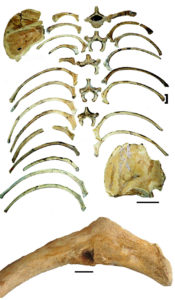UI researchers unearth bones of family of ‘elephant-sized’ giant sloths
December 14th, 2022 by Ric Hanson
(Radio Iowa) – More than 20 years after a southwest Iowan dug a large bone out of a creek bed near Shenandoah, researchers from the University of Iowa are publishing a paper about what turned out to be a family of three of the most prime specimens ever found of an ancient creature. Giant ground sloths were descended from tree-dwellers, but U-I Professor Emeritus Holmes Semken says there’s no tree that could have held these sloths, as they were the size of woolly mammoths.
“They were immense. We’re talking an elephant-sized animal here that’s a sloth,” Semken says. “They were super-sized. When one was sitting down, it would be about eight feet from the ground to the top of its head. If it were standing up, it would be about ten feet, and they had incredibly long forelimbs. If they held those up to pull down the branch out of a tree or something like that, you’re talking about 12 feet.” While today’s tree sloths have a reputation of being very slow moving, Semken says the giant ground sloth of 100-thousand years ago likely would have moved more quickly.
“Some speculate that this particular kind of sloth would hang the babies in trees to protect them from predators,” Semken says. “These definitely were ground dwellers and there’s really no way to measure their metabolism, but they probably were very much like most other animals.” Their feet weren’t configured to run, he says, and they likely were knuckle-walkers. This type of long-extinct Ice Age ground sloth wasn’t unusual, as they were documented in more than 150 places across North America, however, he says the Iowa find was exceptional as the three sloth skeletons were in near-perfect condition.
“Usually, it’s an isolated tooth, a finger bone, a femur,” Semken says. “What’s different about this, finding almost complete animals is almost unheard of. With this sloth, it could either be the first or the second most complete sloth known.” The person who found the bone had a daughter at the U-I and brought the femur in for study. Semken says his jaw dropped and he knew right away that it wasn’t the typical cow, pig or horse bone most folks find, and that he was holding a career-changer.
“Oh, yes, very definitely,” Semken says, laughing. “It’s always exciting to find something new and this was certainly new, no question about that.” He calls the discovery a type of “Rosetta Stone” for understanding the family life of these mysterious animals. After years of careful excavation, the three sets of giant ground sloth bones were eventually uncovered from the Tarkio Valley river bed in Page County. The research team’s findings are being published in the Journal of Vertebrate Paleontology.






